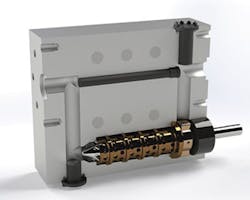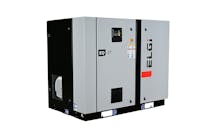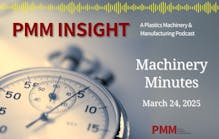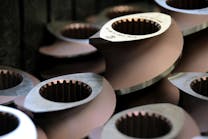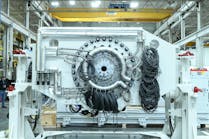Special Report: Single screws, add-on systems aim to optimize melt quality
Optimal melt quality is the goal of recent developments in add-on plasticizing systems and single screws for injection, extrusion and blow molding machines.
REILOY BRINGS NEW SCREWS TO THE MIX
Reiloy USA will bring a new line of mixing screws to market this year that can be configured as distributive or dispersive mixers for low or high shear, President Dave Larson said. The line is suitable for injection, extrusion and blow molding applications.
In development for two years, the Eagle II mixing screw allows users to adjust up to four different variables within the mixing section of the screw. Because users can make these adjustments, the screw can process a rheologically wide range of materials, improve the isothermal quality of the melt, optimize flow rates and increase production, Larson said.
The new mixing screw allows users to adjust the root depth, which changes the mixing volume.
"One thing we learned through testing of this variable is that we can improve the quality of the melt due to changes we can impart to compression in the mixer. Users can intensify the kneading of the material or make the mixing gentle by changing the root depth of the mixer. Typically, compression builds as material is conveyed up the screw. We can start off with a high level of compression and decompress the melt as it is conveyed up the screw, or we can start with shallow compression and deepen it," Larson said.
Reiloy is researching the extent to which mechanical properties of the end product are influenced by adjusting this variable.
Processors also are able to adjust the barrier undercut to change the compression ratio in the mixing section; vary notches within the mixer section to fine-tune flow rates; and modify the number of screw flights to match the processing intensity to the material, Larson said.
The Eagle II mixing screw takes its place beside Reiloy's Eagle mixing screw for low-shear plastics mixing and the Eagle barrier screw for hard-to-melt crystalline resins.
"The design of the screw can be tweaked to achieve a range of performance goals, such as higher flow or faster plastication or more material residence time. The design is determined by its use and the material being processed," Larson said.
Reiloy Metall GmbH, Troisdorf, Germany, a sister company of Reiloy USA that manufactures its own metal powders and formulations, is developing a new hard-surfacing material for screw flights as well as for barrel linings, Larson said. The company expects the new materials to be more resistant to abrasion and corrosion than standard materials.
NORDSON ADDS PLASTICIZING PACKAGES
Nordson Polymer Processing Systems last month launched a complete screw and barrel package for processing polylactic acid (PLA). The new system can be retrofitted to a standard injection molding machine or extruder, said Mark Colella, global product manager for Nordson's Xaloy brand.
Nordson offers two versions of the package as add-ons for injection molding machinery; both use Nordson's Xaloy EasyMelt screw, which delivers improved temperature control and fast screw recovery versus competing screw designs, Colella said. For end products that need optimal clarity, Nordson offers a version that features the company's Xaloy Z-Mixer. Both systems for injection molding PLA incorporate the company's Xaloy X-800 bimetallic barrel liner, which is resistant to wear, corrosion and abrasion.
"PLA can be mildly corrosive to machinery components; therefore, components that resist corrosion are the best choice," Colella said.
The extrusion package comprises an Xaloy Efficient brand barrier screw and an Xaloy Stratablend II mixer.
The company expects the PLA screw and barrel packages to have a long working life, as they utilize corrosion-resistant materials that reduce wear from additives in the PLA resin. Nordson worked with PLA resin manufacturers to optimize screw geometries that minimize start-up issues.
Add-on systems are an increasing focus for the company. Last year, the company introduced its Xaloy LSR package, with a specially designed screw, barrel, seal, valve and nozzle.
Nordson also offers a plasticizing system to produce high-clarity optical-grade PC parts. It incorporates a modified Xaloy Pulsar II mixing screw, a free-flow valve with an internal geometry designed to handle PC, an Xaloy X-800 barrel inlay and a nickel-plated endcap that smooths the transition of the PC melt from the screw to the injection nozzle.
Nordson also developed a system for thin-wall packaging applications and a package for the processing of heavily filled materials, such as 50 percent glass-filled nylon.
The company said that a consolidation of its screw and barrel operations at a new regional hub in Austintown, Ohio, is under way and will be complete by March 2018. Xaloy-brand screws, barrels and front-end components will be manufactured at the new 200,000-square-foot facility, which will have enhanced capabilities for precision manufacturing and a new IT system for seamless coordination with Nordson facilities around the world.
DRAY OPTIMIZING TWO-STAGE SYSTEM FOR PRECISE MOLDING
R. Dray Manufacturing is upgrading its two-stage molding system that it offers as a retrofit package for standard injection presses. The Injection Control Unit (ICU), first offered commercially in 2003 by company owner and developer Robert Dray, combines a fixed-screw extruder that plasticizes the polymer, and a special plunger/ram system that accurately controls hold pressure.
The system produces a homogenous resin at a lower temperature than conventional molding systems. It runs efficiently at both high and low output rates by using advanced extruder designs that are not compromised by also having to perform injection, the company said.
The ICU is an alternative to reciprocating- screw injection molding units that also incorporate nonreturn valve technology. Dray said the use of nonreturn valves and reciprocating screws jeopardizes melt temperature, mixing quality, shot-size consistency and cycle times, and can contribute to accelerated wear of machine components.
Because the ICU separates plasticizing from injection, users can better control shot sizes, allowing the molder to produce standard parts or micro-molded parts without issues relating to material residence times. When using the system, the cycle time is not limited by the plunger recovery time. Injection molders also can use the plasticizing extruder as an in-line compounding device.
"We are in the process of putting out our latest version as a prototype in our lab here in Texas, and that should be completed in the next few weeks. Overall, it will be an upgrade in the electronics and the processing capability," Dray said. With the updated ICU, he is targeting molders that are looking to produce parts that are consistently molded to the correct part weight, rather than overpacked to ensure that the part meets customer weight requirements.
"Every processor is alert to avoiding the production of short-shot parts, but the question that should be asked is, how much resin would not be used if the part was molded on the number?" Dray said the patented ICU is capable of producing a full part consistently at the specified part weight.
ROBERT BARR BROADENS ROLE OF NOVEL MIXING DESIGN
A unique barrel-mounted polymer mixer developed last year by Robert Barr Inc. delivers a wide range of processing benefits. It is driven independently rather than by the feed screw it is linked to and can be substituted for other mixer types, including Maddock, Saxton and Egan styles, President Jeff Myers said.
Last year, the company offered a dynamic version of its low-shear, high-intensity Fluxion polymer mixer. The original version is threaded to the end of an extruder screw; the new version is driven independently and mounts onto the barrel of the extruder rather than the screw.Actuating the mixer independent of screw rotation allows users to control the pumping pressure, pressure drop and shear induced on the material. Users can therefore tie the control of the mixer's speed to a specific shear rate or pressure drop independent of the screw speed, as an additional way of controlling the properties of the melt.
"We are finding that this capability presents new possibilities in extrusion. To our knowledge, the dynamic Fluxion mixer is the first commercial device in the industry driven independent of the screw," Myers said.
Users can adjust shear by setting different speeds for the screw and the rotation of the mixers. They can create higher shear if they are looking to break up agglomerates, or the mixer can act as a type of melt pump that will help maintain or develop discharge pressure. The dynamic Fluxion mixer can control the amount of pressure drop via the speed of the rotor, Myers said. Users can configure the mixer for dispersive or distributive mixing.
As an alternative, users can replace the Fluxion mixer with another mixer or other device. The introduction of a liquid color to the melt downstream, closer to the discharge end of the screw rather than upstream in the feed throat, is an example of a setup that would benefit from the process.
Myers said that 99 percent of the time, processors add liquid color at the feed throat. "There can be an issue because the liquid color is a lubricant and it is being introduced to an area of the screw that requires high friction," Myers said. With the new technology, the company can create an injection port in this device, downstream of the feed throat, where users can introduce the additive into the melted plastic to produce a homogenous mix. They can mount other mixer types or other devices where the Dynamic Fluxion mixer would be positioned.
Barr made the inline dynamic mixer compact so it can be retrofitted into a small space; each mixer size is designed for use with a range of screw diameters. The company has a patent pending for the dynamic in-line mixer, Myers said.
MILACRON DEVELOPS SCREW FOR PACKAGING APPLICATIONS
In collaboration with Robert Barr, Milacron developed a new screw, the VPAK, for injection molding machines making packaging. Milacron has exclusive rights to manufacture, sell and install the screw. The screw design is based on Barr's Variable Barrier Energy Transfer (VBET) screw.
The VPAK is a Milacron-modified VBET screw, but it can be used in the company's aftermarket program for any machine brand, the company said.
The VPAK performs much like the VBET screw it is based on, offering controlled melt temperature, excellent mixing across a range of materials, and stable, repeatable performance, said Mike Sansoucy, VP of sales — Injection Americas. The VPAK screw can be installed as part of a new or reconditioned injection press.Milacron employs modified VBET screw designs in its presses for automotive, medical and houseware manufacturing applications.
TWWOMER REDESIGNS PROVEN TECHNOLOGIES
Tim Womer, consultant and creator of thousands of customized screw, barrel and component designs over the last 42 years, has developed new screw and mixer technologies based on proven designs with expired patents. Womer, the owner of screw design company TWWomer & Associates, created his new TWW Barrier Screw in conjunction with his new Evolution mixer.
The TWW is a modification of a barrier screw design under the Dray/Lawrence screw patent. It is optimized to produce a more homogenous melt. The Dray/Lawrence barrier screw uses a parallel barrier approach as well as an increased helix angle, which allows for wider melt channels. Womer combined this design with the Fusion Barrier Screw, which has been available through Nordson-Xaloy in New Castle, Pa.
Womer also focused on redesigning the mixing section of the Pulsar Mixer, which was originally patented by the late Paul N. Colby, who was owner and president of Spirex Corp. The Pulsar Mixer has a deep channel in the mixing section with milled spherical pockets at the entrance and exit of the mixer. The deep channel and milled pockets are areas where thermally sensitive materials could potentially build up, increasing the possibility of melt-flow stagnation and polymer degradation.
"What I did to improve this area of the mixer was to design a ramp-like element into and out of the mixer section instead of the pockets. This design change streamlined the interior dimensions of the mixer while retaining the flexibility to perform as a low-shear, distributive mixing device," Womer said.
Womer also looked more closely at the design of the spiral Maddock mixer (also called the Egan mixer) to resolve an issue where the melt temperature could increase. "A year and a half ago, I discovered a reason as to why a spiral or twisted Maddock mixer could encounter increased melt temperature," he said.
The typical solution concentrated on increasing the barrier gap between the inlet and outlet channels of the mixer to relieve shear in that tight area of melt flow to reduce the melt temperature, Womer said. However, he discovered that the tight gap was not the cause of the increased shear and melt temperature. He determined that the increased temperature was caused by the restriction of the smaller channels with shorter leads, which in turn caused a pressure rise that the metering section had to pump against.
Womer discovered that longer residence times of the resin within the channel could lead to temperature increases.
"The metering section's pumping action has to work harder to overcome the pressure drop," he said. Womer reduced the number of channels, and changed the lead to a longer pitch so that larger channels could be used. That reduced the pressure drop through the channels, which in turn dropped the melt temperature dramatically.
Mikell Knights, senior staff reporter
mknights@plasticsmachinerymagazine.com
For more information
Milacron LLC,Batavia, Ohio, 513-536-2000, www.milacron.com
Nordson Corp.,New Castle, Pa., 724-656-5600, www.nordsonpolymerprocessing.com
R. Dray Manufacturing Inc.,Hamilton, Texas, 214-368-5424, www.rdray.com
Reiloy USA,Maize, Kan., 316-721-1144, www.reiloyusa.com
Robert Barr Inc.,Onsted, Mich., 517-759-5050, www.robertbarr.com
TWWomer & Associates LLC,Edinburg, Pa., 724-355-3311, www.twwomer.com
